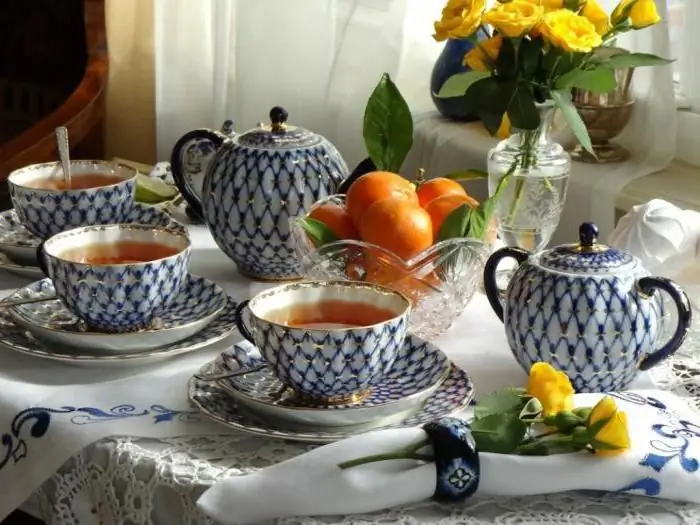2025 Author: Howard Calhoun | [email protected]. Last modified: 2025-01-24 13:10:41
In 1744, by order of Empress Elizabeth, the Porcelain Manufactory was established, which became the basis of the Russian school of porcelain. The reason for creating this enterprise is fashion. In the 18th century, "white gold" was made in China and some European countries. In the same year, the Swede Christopher Gunger, hired to organize production, took up his duties. It would be an exaggeration to say that he succeeded in this field, because in four years of work he managed to make only six small cups, moreover, crooked and darkish. But a start was made.

Baron Cherkasov supervising the process, disappointed in foreign specialists, decided to trust the Russian chemist Dmitry Vinogradov, who worked with Lomonosov himself, and was not mistaken. The Imperial Porcelain Factory has finally begun to produce products that are not only not inferior in quality, but also superior to European ones.
Functions of production in those years were rather representational than commercial. Diplomatic gifts demonstrating that “we can do it too”, gifts from court nobility and other souvenirsaccounted for the bulk of the production. The imperial porcelain factory was the property of the royal family, self-sufficiency and profitability did not matter.

Quite different tasks were set for this unique enterprise by Catherine the Great. In modern terms, she demanded a rebranding and a complete reorganization of production. The purpose of these measures is "the satisfaction of all Russia." Sales did not constitute a problem, the fame of the high quality of Russian porcelin spread not only within the empire, but also far beyond its borders. To make a profit, it was only necessary to support it, and the price of buyers, among whom were aristocrats and monarchs, did not care.
The new model master, the famous French sculptor Rachet, who was invited to the Imperial Porcelain Factory and established classicism as a corporate identity, was of great benefit.
All Russian autocrats, who owned this unique enterprise for a century and a half, closely followed its activities. Only under Alexander II there was a certain decline in production. They even wanted to close the imperial porcelain factory, but this was prevented by the next sovereign, Alexander III, who decided to make it a model for all private manufacturers in the industry.

The enterprise experienced its heyday in the last years of the existence of the Russian Empire. The Petersburg Imperial Porcelain Factory was equipped with the most advanced technological equipment, which made it possible toby 1918, despite the devastation and civil war, resume production under the tutelage of the People's Commissariat for Education.
The very idea of using chinaware for propaganda purposes may seem naive and absurd to a modern person, but such a paradoxical approach gave impetus to the development of a completely new direction of art, hitherto unknown in the world. The combination of perfect forms, inherited as “underwear” from the royal factory, with futuristic and suprematist painting, Soviet heraldic symbols, proletarian slogans created a special style, revolutionary and unique.

However, this direction did not last long. In the 1930s, another style triumphed, pompously official, caustically called by someone "Stalin's vampire".
The style has changed, but the highest quality has remained unchanged, the products of the Lomonosov Porcelain Factory (the name of the enterprise in the last Soviet years) are in steady demand.
Today, the Imperial Porcelain Factory still occupies a leading position in the industry. The dishes produced at this enterprise are not only sold domestically and abroad, but also supplied to the Kremlin and other government agencies.
Recommended:
Porcelain tile from China: features, types and reviews

In recent years, porcelain stoneware has become increasingly popular among finishers and property owners. China is one of the leaders in the production of this versatile building material. And if earlier everything that was produced in China was considered low-quality consumer goods, now the inscription “Made in China” no longer alarms buyers. Numerous sincere and positive reviews of builders and customers are proof of this
Bogdanovich Porcelain Factory: dishes with traditions

Bogdanovich Porcelain Factory (Sverdlovsk region) produces a variety of dishes made of porcelain, faience, majolica, which can be used both at home and in restaurants. The quality of products is always high, the company works with porcelain of different temperatures, the last stage of processing is done manually, which makes the products smooth and perfect
Weight of 1 m2 of porcelain stoneware. Characteristics and properties of porcelain stoneware

When you know the weight of 1 m2 of floor tiles, you can also look at other characteristics, such as frost resistance. This indicator is one of the main ones and determines the possibility of operation not only indoors, but also outdoors. Technical properties are measured by 50 temperature cycles, which are equal to the same number of years
Lomonosov Porcelain Factory: history, products and hallmarks. Porcelain figurines of the Soviet period

What is the history of the Lomonosov Porcelain Factory? What products does he produce today? You will learn about this from our article
Dobrush Porcelain Factory: description, company history, customer reviews

Dobrush Porcelain Factory is the only porcelain manufacturer in Belarus today. What year was the company founded? What products does it produce? What is remarkable and what is valuable about his products? Our article will tell about all this

